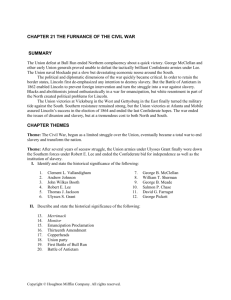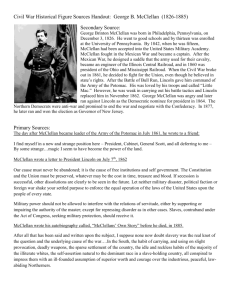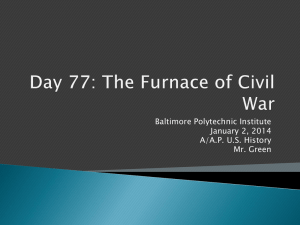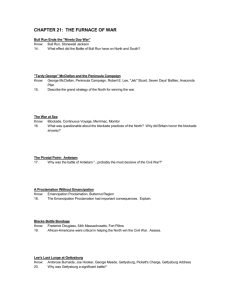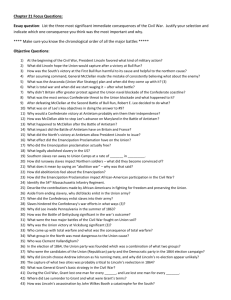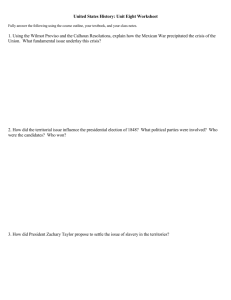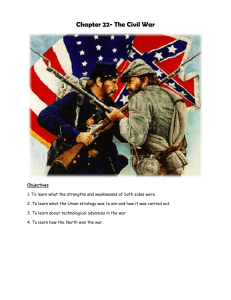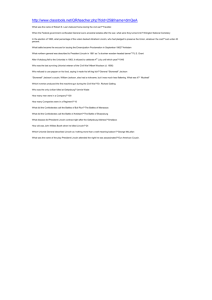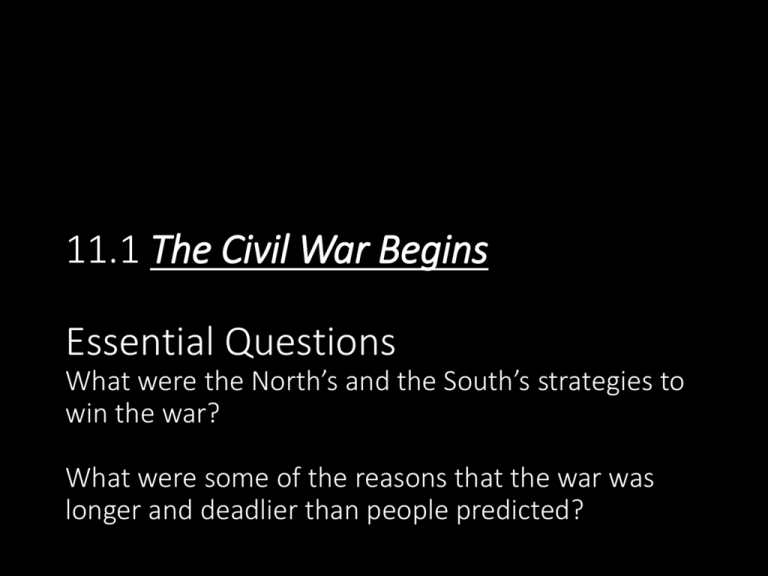
11.1 The Civil War Begins
Essential Questions
What were the North’s and the South’s strategies to
win the war?
What were some of the reasons that the war was
longer and deadlier than people predicted?
George McClellan
Robert E Lee
Ulysses S. Grant
Stonewall Jackson
David G. Farragut
Three in One
“90 Day War”
Anaconda
Shiloh
First Bull Run
Second Bull Run
Ft. Sumter
Ft. Donelson
Antietam
New Orleans
1.First shots fired in the Civil War.
2.First battle between armies of
North and South.
3.The over-cautious commander for
the Union during the attempt to
capture Richmond in 1862.
4.Bloodiest single day of the Civil
War
5.The general who saved the day at
First Bull Run for the South.
Lincoln’s Union
• March 4, 1861 – Lincoln’s Inauguration, 7
states seceded: TX, LA, MISS, ALA, GA, FL,
SC
• Lincoln’s inaugural address: “Physically
speaking, we cannot separate.”
• Why?
http://memory.loc.gov/cgi-bin/map_item.pl
Charleston Harbor S.C.. Bombardment of Fort Sumter.
Ft. Sumter: Cause & Effects
CAUSES:
• Geography: Fort was in mouth of harbor of Charleston,
SC
• Time: Fort needed more provisions to hold on
• What was Lincoln’s dilemma??
http://memory.loc.gov/cgi-bin/map_item.pl
Charleston Harbor S.C.. Bombardment of Fort Sumter.
Ft. Sumter
• April 12, 1861: Confederates
bombard Ft. Sumter
• Federal garrison surrenders after
36 hours
• NORTH:
• unifies and settles in for a long
fight
• volunteers enlist
• blockade begins
• SOUTH:
• Becomes aggressor
• boosts overconfidence
• BORDER STATES:
• First blood drawn by South stay with the Union
Fort Sumter Flag
Note that there are 33 stars.
Why is that important?
Whose War? War for What?
•Lincoln calls
• After Sumter: Who goes next?
for 75,000
ARK, TENN, NC, AND VA
volunteers.
•Why such a
• Richmond, VA is capital of Confederacy
small number?
• BORDER STATES:
MD, DEL, W.VA, KY, MO, Indian Territory
• What about West Virginia??
• Lincoln suspends habeas corpus in MD – Baltimore is site of
first blood spilt in war.
Lincoln’s Cause:
UNION, NOT ABOLITION. WHY?
Lincoln cannot lose Southern Ohio, Indiana, &
Illinois NOR the Border States!
“I think to lose Kentucky is nearly the same as to lose
the whole game. Kentucky gone, we cannot hold
Missouri, nor, I think, Maryland. These all against
us. And the job on our hands is too large for us. We
would as well consent to separation at once,
including surrender of this capital.”
Unionists of East Tennessee swearing by the flag
Unionists of East Tennessee swearing
by the flag
Like the citizens in western Virginia,
people in eastern Tennessee remained
faithful to the Union. Men like those
shown here swore allegiance to the
United States flag and tried to split the
state in two--one rebel and the other
loyal--but Confederate troops put a stop
to their efforts. (Library of Congress)
Copyright © Houghton Mifflin Company. All rights reserved.
The War comes to “Mobtown”
• Baltimore was nation’s 2nd largest city at the time
• Baltimore was infamous in the US for its unruly mobs and riots
• Gangs ruled the city: Plug-uglies, Red Necks, Gladiators, Black Snakes, Blood
Tubs and Spartans…
• The Know Nothings had utilized violence during the election year of 1855.
• Only 9% of Maryland had voted for Lincoln or Douglas.
• Lincoln traveled incognito through Baltimore on the way to his inauguration
due to rumors of an assassination plot.
Trouble Brews…
• Marylanders were divided over both secession and Lincoln’s handling of Ft.
Sumter (attacked on April 12th).
• Marylanders, like Virginians, found Lincoln’s April 14th call for volunteers to
“suppress” the rebellion deeply troubling, even provocative. Sixth
Massachusetts Regiment answers Lincoln’s call for 90 Day volunteer
enlistment.
• Five unarmed companies of Pennsylvania militiamen are set upon by mobs
in Baltimore.
• Many soldiers are hurt.
• The mob focuses its attack on the one free black in uniform, slashing and
stabbing him with knives
• Baltimore officials urge Lincoln to send no more troops through the city.
http://www.citypaper.com/news/story.asp?id=3506
“Another Lexington”
or another “Boston Massacre”?
• 6th Mass. Leaves Boston on April 17th and arrives in Baltimore April 19th.
• An mob of approx. 5,000 Baltimoreans attack the militiamen. Many on both sides of
fighting are wounded.
• 21 killed: (5soldiers). 100’s injured.
• Pvt. Luther Ladd, aged 17, hit in the head and shot while on the ground – dies of
his wounds.
• Corporal Needham, shot in the neck and stomped to death by the mob.
• Last company to march sustains 25% casualties.
• Snipers fire at the train from Baltimore to Washington, DC
THESE ARE THE FIRST TROOPS KILLED IN THE CIVIL WAR.
AFTER EFFECTS
• On April 20th the Governor, Mayor of Baltimore, and Police Commissioner order
all bridges leading into the city destroyed.
• Lincoln censors all telegraph offices. Seizes transcript records.
• Suspected “traitors” and secessionists are arrested.
• September 1861: Lincoln suspends habeas corpus and orders the governor,
mayor, chief of police, many prominent citizens, legislators, and newspapermen
arrested.
• Most arrested are held in Fort McHenry and other northern forts for years,
without trial.
• Baltimore is placed under martial law. Union troops occupy and fortify Federal
Hill.
Union Artillery at Fort Federal Hill, Baltimore, 1862
Photographed by David Bachrach
MHS Library, Special Collections Department
http://www.mdhs.org/library/MDF3.html#32
“After the riots of
1861, Baltimore
illustrated the
nation’s divided
sympathies. If you
were for the
Confederacy, it was
an occupied city. If
you favored the
Union, General
Butler and his
troops were
protecting the city
from the rebels.
Legend reports
that the fort’s
troops enjoyed
pointing out to
nervous locals that
the cannons were
aimed at the
Washington
Monument, located
in the center of the
city, in case of
insurrection.”
Balance of Power
SOUTH
• Defensive Strategy
• Better officers
• Military Culture
• Limited transportation
• Limited manufacturing
• Limited population (slave
revolution?)
NORTH
• Offensive Strategy
• Incompetent/Hesitant
Officers
• Urban culture
• Extensive ports&
transportation system
• Extensive Manufacturing
• Immigration/Population
booming
WAR STRATEGIES
THE NORTH’S
“ANACONDA” PLAN
1. Naval blockade of
Southern ports
2. Control the Mississippi
and split Confederacy in
two
3. Capture Richmond, the
Confederate Capital
THE SOUTH’S PLAN
1. Fight a defensive war
2. Secure recognition and
support from Europe
3. Negotiate an armistice
Scott's Great Snake
Scott's Great Snake
General Winfield Scott's scheme to surround the South and await a seizure of power
by southern Unionists drew scorn from critics who called it the Anaconda plan. In
this lithograph, the "great snake" prepares to thrust down the Mississippi, seal off the
Confederacy, and crush it. (Library of Congress)
Copyright © Houghton Mifflin Company. All rights reserved.
% Northern
% Southern
Total Population
71
29
Free Males
81
19
Wealth Produced
75
25
Industrial Workers
92
8
Factory Production
91
9
Textile Production
93
7
Firearms Production
97
3
Railroad Mileage
71
29
Iron Production
94
6
Coal Production
97
3
Livestock
60
40
Farm Acreage
75
25
Wheat
81
19
Corn
67
33
Cotton
4
96
Merchant Ship Tonnage
90
10
Naval Ship Tonnage
96
4
Which side has the
obvious Economic
Advantage?
Which Categories
are most important
advantages?
Bull Run (1st Manassas)
July 21, 1861
• Optimism runs high, on both
sides……
• Lincoln calls up militia for 90
days
• Many Expect a short,
bloodless, war
• Union outnumbers
South….but….
• Why does the South win?
• Stonewall Jackson
• Humiliating retreat to DC…
EFFECTS:
1.Lincoln calls for 500,000
men with 3 year
enlistments…What does
that mean?
War will not be short or
bloodless
3.Lincoln replaces
McDowell and
appoints…….
George McClellan
commander.
McClellan’s Peninsula Campaign
• 1861: George B. McClellan given command of Army of
the Potomac
• ***Good organizer and drillmaster – VERY CAUTIOUS
• trained troops well, popular with them
• Spring 1862: McClellan moves, finally, on Richmond
• Union stalls at Richmond, routed in Lee’s counterattack, the Seven Day’s Battles
HOW WOULD A VICTORY FOR McCLELLAN HAVE
CHANGED THE WAR?
Map: McClellan's Campaign
McClellan's Campaign
The water route chosen by McClellan to threaten Richmond during the peninsular campaign.
Copyright © Houghton Mifflin Company. All rights reserved.
Robert E. Lee
Robert E. Lee
Lee takes command of Confederate
forces after Johnson is wounded at
Richmond during the Peninsular
Campaign. Responsible for aggressive
Southern strategy during Seven Days
Battles.
Both General Grant and General Lee
were West Point graduates and had
served in the U.S. Army during the War
with Mexico. Their bloody battles
against each other in 1864 stirred
northern revulsion to the war even as
they brought its end in sight. (National
Archives)
Copyright © Houghton Mifflin Company. All rights reserved.
EFFECTS OF PENINSULAR CAMPAIGN
• McClellan removed from command
• Hardens North’s resolve
• Move toward total war
• Embrace Anaconda Plan and Emancipation as
strategies (vs. moral decisions)
• Invade Mississippi and Ohio rivers, spreading war
to the west and deep south
Forts Henry & Donelson
• Ft. Henry- February 6, 1862
• Strategic fort on Tennessee River
• Captured by Grant
• Ft. Donelson-Sieged February 11-16,
1862
• Southern Fort on Cumberland River
• Gun boats on the rivers aided Union
forces
• Effect?
• Mississippi River was open to Union Forces
Shiloh
• April 6-7, 1862
• Confederates undertake surprise attack against Grant
• Looks like Grant will lose but is able to fall back and regroup forces
• Confederate General Sidney Johnson is killed- Considered the best
General in the United States before the War
• April 7- Re-enforced Union troops counter attack and defeat the
Confederates
• Effects• Northern control of Tennessee
• 23,746 casualties
• Use of Scouts and trench warfare becomes common place
Admiral David G.
Farragut captures New
Orleans for North, moves
up Mississippi.
New Orleans- Falls on
May 1st 1862
Anaconda Plan is
beginning to work!
Lower Mississippi
• Admiral David G. Farragut
captures New Orleans for North,
moves up Mississippi.
• New Orleans- Falls on May 1st 1862
• Eventually takes most of Lower
Mississippi including Baton
Rouge LA and Natchez MS
• South’s last strong hold on river
is Vicksburg
• Anaconda Plan is beginning
to work!
Map: The Anaconda Plan and the Battle of Antietam
Copyright © Houghton Mifflin Company. All rights reserved.
Second Bull Run (2nd Manassas)
• After Richmond defeat McClellan replaced by Gen. Pope as commander of Army of
the Potomac
• Lee moves north toward Washington, DC
• Gen. Pope engages Lee at Second Bull Run, August 29-30, 1862, and is crushed.
• Lee and Army of Northern Virginia move into MD, hoping to stir rebellion.
• MD stays neutral
• Armies meet at Antietam Creek, Maryland on Sept. 17, 1862
Map: The War in the East, 1861-1862
The War in the East, 1861-1862
Union advances on Richmond were turned back at Fredericksburg and the Seven Days' Battles, and the Confederacy's
Copyright © Houghton Mifflin Company. All rights reserved.
invasion of Union territory was stopped at Antietam.
Antietam, September 17, 1862
• McClellan returned to command
• Lee swings north and crosses the Potomac
• Lee’s battle plans are discovered, showing his division of
forces; McClellan does not act on info for 18 hours!
• It is the bloodiest day of the war: 23,000
(2x the number of dead and wounded on D-Day)
• Is it McClellan’s greatest blunder? Could have ended war?
Antietam
Antietam
In the photograph of Antietam, dead rebel gunners lie next to the wreckage of their
battery. (Library of Congress)
Copyright © Houghton Mifflin Company. All rights reserved.
Antietam dead, Confederates lined for burial
Antietam dead, Confederates lined for burial
This photograph of corpses awaiting burial was one of ninety-five taken by Mathew
Brady and his assistants of the Antietam battlefield, the bloodiest single day of the
war. It was the first time Americans had seen war depicted so realistically. When
Brady's photographs went on display in New York in 1862, throngs of people waited
in line to see them. (Library of Congress)
Copyright © Houghton Mifflin Company. All rights reserved.
BATTLE
Ft. Sumter
Bull Run
Shiloh
Lower Mississippi
Peninsula
Campaign
Antietam
DATE
LOCATION
LEADERS
WINNER
SIGNIFICANCE/OUTCOME

